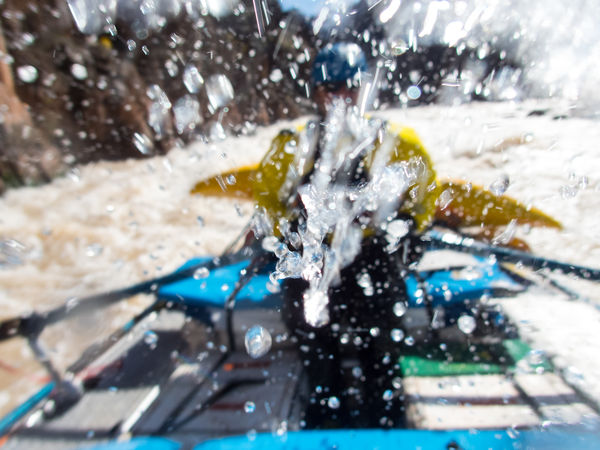Kayaks and Cameras
Mar 16, 2018 08:58:33 #
crbuckjr
Loc: Naples FL
In the Galapagos I was afraid to take my D750 in the kayak. I used my waterproof point and shoot . I missed some great shots! Next time I will make sure my insurance is up-to-date and take along a waterproof bag.
Mar 16, 2018 09:13:25 #
ole sarg
Loc: south florida
Let me get this straight first time in a kayak a craft that is very easy to tip over and you don't want to dunk your gear, you have experienced kayakers who use water proof cameras and you are not sure you if you should take your good gear. To be specious, do they let you out alone? I think you have answered your own question after considering the facts!
Pixelpixie88 wrote:
Yes...I am really not wanting to do that!
Mar 16, 2018 09:13:48 #
cytafex
Loc: Clarksburg MA
Pixelpixie88 wrote:
I am hoping to join friends this summer on some ka... (show quote)
Have been involved with whitewater river guiding for over 27 years. When I bring a DSLR it's inside a Watershed dry bag which are expensive but they work really well and last much longer than roll top dry bags. Also I have an Olympus TG-4 that is waterproof that I clip to my PFD which is handy and produces nice images considering. You want to have gear accessible easily.

Mar 16, 2018 09:22:28 #
nikonboy wrote:
I have taken my pretty good stuff out in kayaks fo... (show quote)
I love your message....thank you!
Mar 16, 2018 09:23:28 #
d2b2 wrote:
The last kayak venture was in a two-person kayak. ... (show quote)
Love it....thanks for the laugh!
Mar 16, 2018 09:25:05 #
If there is no white water involved, then risk taking the DSLR of choice with good dry bag. Use two dry bags to be sure. Perhaps one for the camera gear then place this one inside another dry bag for any other clothing or other gear you way want to keep dry. If you want easy access to the camera in your dry bag be sure to have a line secured to it to retrieve the dry bag if it sinks (dry bags may keep your equipment dry, but also may sink if there's not enough air in it to float and hence the line). Note: Not all dry bags are alike. Test the dry bags to see if you're using them correctly and if moisture us getting inside. Test them without camera gear of course.
Mar 16, 2018 09:26:05 #
NormanTheGr8 wrote:
For on water I have a waterproof ammo box I have found I can fit my 7D with a 100-400inside 1 latch to open, added a little padding a lens cloth or 2 and a brush and teather it to the boat . Or my SX50 in a ziplock bag works great also for less bulk
The box sounds like a great idea!
Mar 16, 2018 09:26:52 #
RRS
Loc: Not sure
Pixelpixie88 wrote:
I am hoping to join friends this summer on some ka... (show quote)
First question Marsha, are you already an experienced kayaker or new to the game? Are you comfortable on the water? Is so I'll tell you that most of my friends that do partake of water photography shoot 500 f/4.0 primes or the 100-400 zoom. BTW all just so happen to be shooting Canon gear and yes a dunking can and does happen. A friend went under two years ago and his insurance replaced both camera and lens and that was from a fresh water dunking. Have fun and let us know on what you decide and why.
Mar 16, 2018 09:27:52 #
Marilia wrote:
I use and older Canon SX40, great zoom and not a big deal if it gets wet ;)
That's a great idea. I do have a second camera body. Thanks.
Mar 16, 2018 09:29:31 #
I'm not sure how accessible it would be in a kayak, but I have taken a good camera canoeing in the safety of a military ammo box. They're water tight. I tied a rope to the handle so it couldn't float away. I only took the camera out when I knew that it was safe and got some decent photos. Oh, yes, my Dad and I did manage to tip the canoe when we got entangled in brush on one trip. The camera stayed completely dry.
Mar 16, 2018 09:31:12 #
CanonShot wrote:
There is a lot of good advice here that likely val... (show quote)
I will be on small rivers...like you. I'm thinking of the my back-up camera with a lens..after some experience! Thanks!
Mar 16, 2018 09:32:19 #
wteffey wrote:
If you are going to be responsible for paddling an... (show quote)
More good advice..thanks!
Mar 16, 2018 09:40:57 #
If there is no white water involved, then risk taking the DSLR of choice with good dry bag. Use two dry bags to be sure. Perhaps one for the camera gear then place this one inside another dry bag for any other clothing or other gear you way want to keep dry. If you want easy access to the camera in your dry bag be sure to have a line secured to it to retrieve the dry bag if it sinks (dry bags may keep your equipment dry, but also may sink if there's not enough air in it to float and hence the line). Note: Not all dry bags are alike. Test the dry bags to see if you're using them correctly and if moisture us getting inside. Test them without camera gear of course. Note many Pentax DSLR bodies and many lenses are WR (weather resistant) with moisture seals to the elements and rain but probably not to a total submersion. https://www.diyphotography.net/are-pentax-cameras-that-weather-proof/
Mar 16, 2018 09:42:34 #
I bring my d7000 with a 70-300 and just be careful. So far so good. Make sure you have a floating waterproof case/bag for it when you are not using it.
Mar 16, 2018 09:45:27 #
nikonboy wrote:
Marsha, I made a short 12 minute video of photography from a kayak which includes most of what I have learned on the subject, and many examples of the photos I have managed to take from a kayak. I am pretty sure you will find it helpful: https://www.youtube.com/watch?v=_iYpQuDjYag&t=52s
Enjoy. If the link doesn't work search YouTube for Photoguy73 kayak.
Enjoy. If the link doesn't work search YouTube for Photoguy73 kayak.
Your video is AMAZING! It really inspires me. Thanks for giving me the link. Now, here is my link to Flickr...if you look at some of my photos, you'll see why I want a better camera than a point and shoot.
http://www.flickr.com/photos/52356995@N07/
If you want to reply, then register here. Registration is free and your account is created instantly, so you can post right away.


